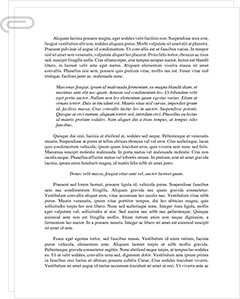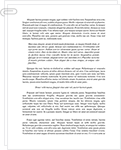 Study Document
Study Document
How Women Can Mitigate the Impacts of Postpartum Depression Research Paper
Pages:5 (1613 words)
Sources:4
Document Type:Research Paper
Document:#76239985
Background of postpartum depressionDepression has quickly become a major public health concern for those in the United States. COVID-19 and its resulting health consequences have exacerbated many of the impacts of depression on women within developed worlds. The pandemic for example, caused massive and unexpected job loss of millions of families. Many of those impacted such as travel, tourism, and retail are still reeling from the economic consequences of the virus. These elements can combine to severely impact the psychological wherewithal of individuals in society, particularly women. Child bearing is one of the most powerful and stressful events a woman can experience. If unprepared financially, or healthcare wise, this stress can result in depression. For once Women are nearly twice as likely to experience depression during their childbearing years as compared to men. Postpartum depression is defined by academics as an episode of non-psychotic depression according to standardized diagnostic criteria that occurs one year after child birth.Issues of importance of postpartum depression (causes, possible treatments, effects)According to research the causes of postpartum depression with an individual can vary dramatically. In many instances, the mothers experience after child birth can vary dramatically which correlates heavily to depression statistics. Generally speaking, postpartum depression is caused by a litany of risk factors which often include anxiety, stress, poor social support, and previous history of depression outside of pregnancy. In other instances, depression can be related to stress related to childcare, low self-esteem, marital status and relationships with their partners. Currently research has not found a correlation between postpartum depression and race, education, or age (Beck, 1995).Essentially the data has shown that the cause of postpartum depression fall into three primary categories of economic, social, and psychological. Each of these categories is related to the other, but individual, they can have a disproportionate impact on the mother after childbirth.From an economic perspective, the cost of children has risen every year for the past decade. According to the U.S Department of Agriculture, the average cost of raising a child form birth to 18 years old is roughly $234,000 per child. The primary elements of this figure include housing, food, childcare, healthcare. In addition, this figure does not include college expense which can easily increase the figure by $100,000. Parents with low socioeconomic status often face the daunting task of trying to provide for a child with little to no financial means. This issue is further compounded if the mother works in an industry that his highly sensitive to economic shocks and recessions such as travel, tourism or retail. As noted in the introduction, COVID-19 has contributed heavily to risk factors of postpartum depression as many employees in the above sectors were laid off or furloughed. In addition, these women were often unable to find additional employment as their skills are antiquated and not well suited to transfer to unrelated professions. Still further, women must contend with salaries, wages, and benefits that are often less than their male counterparts, further inhibiting their overall ability to take care of their children. All of these economic factors can often coalesce to become daunting and overwhelming for the mother. These issues are compounded if the mother is single without a strong support system (Jacobsen, 1999).The next cause…
…not heavily involved in the childs life or neglects the women in terms of a more fulfilling relationship. Other treatments include, non-directive counseling can be used simply to allow women to vent their overall frustrations or anger. Non directive counseling is often referred to as simply listening session where the counseling does not direct the course of the conversation or the action. It allows the women to come with their own answers and solutions themselves rather than being told.How postpartum depression might be dealt with in the next 10 yearsPostpartum depression is expected to become much more frequent in the future. Society is seeing much more discouraging data as it relates to women and the pressures placed on them. For example, income inequality is still a major factor for single mothers looking to support a family. In addition, the divorce rate is roughly 50% thus causing household damage that impacts both the mother and the child. Sexism also plays a role in the ability for women to move up the career latter which also limits their ability to support a child.To properly deal with these issues and how they related to postpartum depression, women must plan much more thoroughly. They should have a very strong support system in place prior to pregnancy. From a financial perspective both the women and her partners should have adequate financial backing before a child is born. In addition, if a split does occur, there should be a form of both emotional and financial support to help the mother in her early years of caregiving. The mother herself must limit social media usage and develop…
Related Documents
 Study Document
Study Document
Women S Health Initiative Intervention
Maternal MortalityIntroductionMaternal mortality is a serious public health concern in the United States, with rates that are disproportionately higher among Black and Hispanic women compared to their white counterparts. According to recent data, the U.S. maternal mortality rate is one of the highest among developed nations, reflecting significant systemic healthcare inequities (Njoku et al., 2023). The leading causes of maternal deaths include complications related to chronic conditions such as hypertension,
 Study Document
Study Document
Experimental Method Design Project
Experimental Method Design Project Impact of different types of support systems on postpartum depression in women The research question under study is the degree to which support structures can affect the severity of the symptoms of postpartum depression. Other questions that may be considered include whether certain support structures are more valuable than others, such as the father of the child vs. family members and friends, or formal, professional supportive structures such
 Study Document
Study Document
Extending Medicaid Coverage One Year Postpartum
Extending Postpartum Medicaid to One YearBreastfeeding has health benefits for both babies and mothers. Breast milk provides a baby with ideal nutrition and supports growth and development. Breastfeeding can also help protect baby and mom against certain illnesses and diseases. � U.S. Centers for Disease Control and Prevention, 2023As the epigraph above makes clear, postpartum care is critically important for the health and wellbeing of both mothers and infants following
 Study Document
Study Document
Mental Health Effects of Domestic Violence
Women�s Mental Health and Domestic ViolenceSharma, K.K., Vatsa, M., Kalaivani, M. & Bhardwaj, D. (2019). Mental health effects of domestic violence against women in Delhi: A community-based study. Journal of Family Medicine and Primary Care, 8(7), 2522-2527.Social science discipline the article represents: Psychology and Sociology.Psychology: It represents the field of psychology because it focuses on mental health processes.Sociology: It represents the field of sociology because it focuses on women�s experiences
 Study Document
Study Document
Menopause Midlife Change Menopause and
self-absorption. This becomes a time of self-reflection and if all bodes well a time of increased creativity (Erickson & Erickson, 1997). However, should there be increasing family or financial stress, if there has been problems with their husband or children or they find themselves with looming bankruptcies, the likelihood of depression increases tremendously (Robinson, et.al., 2001) and the maladaptations of overextension and rejectivity (Erickson & Erickson, 1997) can lead
 Study Document
Study Document
Pregnancy Rates and Educational Attainment
These number from Halifax and Brunswick counties are alarming not only because of the high correlation between teen pregnancy and dropping out of school, but also because the interrelationship between educational proficiency and teenage pregnancy. For example, only "forty-one percent of teenagers who begin families before age 18 ever complete high school." (the National Campaign to Prevent Teen Pregnancy, 2006). Furthermore, "parenthood is a leading cause of high school drop




